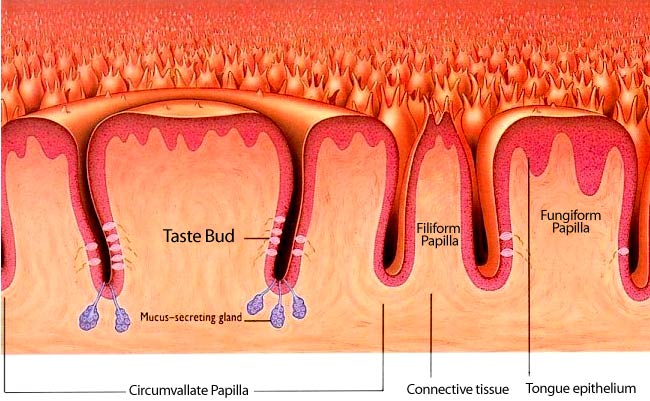1.2 Taste & the Construction of the Mouth
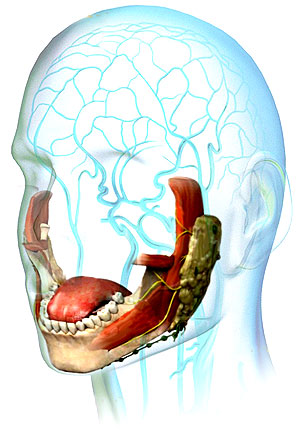
There must have been a transitional period in every primitive group, during which, a member of the family congregated around a fire after a meal would suddenly collapse and die. We picture early peoples in a long series of trial and error, experimenting with the tastes of local flora and fauna, to find, often at much cost to their health, which articles could be eaten safely and which could not. Items could then be confidently added to the growing list of recognised animals, fruits, nuts, berries, yams and other food sources in the environment. This learning process almost certainly would have begun in the mouth, rather than via the sense of smell.
So we shall begin with the mouth.
It is remarkable, given the fact that all humans have one, that so few really understand the way the mouth functions, let alone its construction. To most, the mouth is simply the opening for shoveling down food and drink - that is all. Well, perhaps not - a little kissing leading to sexual activity and of course, a mouth is necessary if we are to talk and to taste. Most importantly for our study however, is that the sense of taste encourages appetite and protects us from poisons. An examination of the anatomy and physiology of gustation (taste) reveals how this is accomplished.
The Mouth
The mouth is best viewed as a chemoreceptor by which we detect alterations in the chemical nature of our environment. To achieve this, the mouth is constructed of a number of parts, all of which play a vital role in the interpretation of smell and taste, and ultimately the delivery of the sensation of 'flavour.'
The primary structure of the mouth is the jawbone, called the temporomandibular joint, without which one simply cannot process food. Embedded with teeth, it is responsible for hinge movements, chewing, protrusion and withdrawal. Teeth play a vital role in the breakdown of foods into smaller, manageable pieces which eventually form a bulbous pulp that can be swallowed. Food stuck in cavities, holes in one's teeth and toothache all affect one's ability to taste and break up food. The teeth and periodontal membrane are also sensitive to pressure and temperature. Life without one's original set of teeth can be hell, as the unlucky owner of a new set of false teeth will tell you.
Surrounding the teeth are the inner lip and gum areas which are often ignored in discussions about taste but are vital in the determination of foods and drinks that are safe to consume. The lips provide an early warning signal for bitter flavours (most toxins are in fact bitter compounds and the tongue will certainly confirm the sensation). This early warning from the lips should signal the brain powerfully enough to prevent the intake of poisons - should these early warnings be ignored, signals will be relayed to it from the brain which will trigger spitting. The lips have a remarkable sensibility to texture (try eating the casing of a chestnut), temperature and bitterness, whereas the gums are particularly sensitive to tannins (tannins are a complex organic constituent of wine occurring in greater quantities in reds than in whites and convey fullness of body and astringency (grip) in dry reds.) Roll a red wine around the inner lip and gum area of your mouth. If a wine is excessively tannic you'll experience a tingling sensation on your gums similar to the after effects of a dentist's needle. An excessively tannic wine creates the impression of your teeth departing your mouth.
The cheeks also play an important role. They contain the solids and fluids we put into our mouth and help transfer food in the mouth from the inner lip and gum areas. This may seem a trite point, but regulating the volume of food in the mouth is critical if we are to avoid choking. The cheeks are sensitive to tactile and thermal stimuli. Put something prickly in your mouth, or drink a very hot cup of tea, you'll soon feel the cheeks working. The cheeks also act as a warming mechanism for cool liquids, liberating the volatile molecules, allowing them to move into the retro-nasal cavity heightening the sensation of flavour. Some authorities claim that there are no taste buds to be found in the cheeks. However, other researchers indicate evidence of taste buds, particularly in children.
The next part of the mouth is the hard palate, located at the top of the mouth, which has a wrinkled surface that produces traction to prevent the food slipping around the mouth. It also is sensitive to temperature.
The salivary glands' ability to function properly influences one's taste perception. Saliva and mucous are necessary to lubricate the mouth for the purposes of swallowing and speaking. The oral cavity is almost constantly flushed with saliva, which floats away food debris and keeps the mouth relatively clean. Saliva also contains lysozyme, an enzyme that destroys many bacteria and prevents overgrowth of oral germs. Saliva fluids act as a medium for oral stimulants, secreting amylase and other constituents, as well as playing a function in that vital role of thirst & water balance.
It is already apparent that the design of each part of the mouth is concerned with heightening sensitivity to toxic or otherwise damaging substances, so preventing them from entering the body. The mouths construction is such that fluids and foods can be held, assessed and spat out if necessary. Research by Roger Segelken at Cornell University suggests humans can make such taste dependent decisions within fifty milliseconds - that's fifty thousandths of a second. (In the past, humans were considered to have an unusually slow sensory system. Rats, on the other hand, are by comparison leisurely assessors, taking 125 milliseconds to decide about a taste. The reason for the variance again lies in the design of each particular mouth. Humans are suction drinkers. The rat, on the other hand drinks by licking and can't vomit. If the rat makes a mistake, it's dead.)
But by far the most intriguing and complex subject in the human mouth is the tongue.
Written about for centuries and the subject of discussions amongst philosophers, medical practitioners, bio-chemists and psychologists. For a long time the tongue was considered the only organ of taste, one of the five classical senses, and with the beginnings of microscopic anatomy in the XVIIth century, the question arose: "Are there in the tongue or elsewhere, specific organs of taste?"
The Tongue in Detail
If you look at your tongue in a mirror, you'll notice its top surface is dotted with small pinkish red protuberances, particularly at the front of the tongue. These are not taste buds, for taste buds are invisible to the human eye. Rather, they are four types of 'papillae', each of which perform different functions.
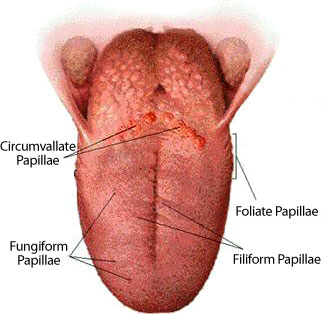
|
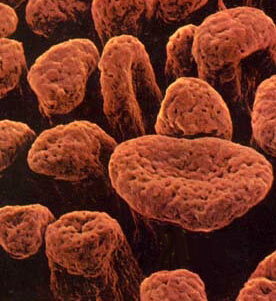
|
| General locations of the different papillae on the tongue. | Electron microscope image of various papillae. |
Filiform Papillae are the most numerous and are located at the center of the tongue, but do not contain taste buds. Their function has been described as a mechanical aid in rasping and mastication, using their small hair like projections for grasping food.
Fungiform Papillae are red, mushroom shaped and appear to be scattered amongst the filiform papillae. They are in their greatest numbers at the tips, sides and the back end of the tongue and are associated with approximately 18% of the tongues taste buds.
Foliate Papillae account for approximately 34% of the tongue's taste buds and are located at the sides of the tongue and at the rear and have up to 20 ridges. They are predominately sensitive to sour tastes. On average there are 5.4 foliate papillae per side of the tongue, with 117 taste buds per foliate papillae.
Circumvallate Papillae are rather large mushroom like forms, located at the rear of the tongue and form an unusual V pattern. There are not many of them, usually between 8 - 13 in number and they are quite large measuring between 3 - 5 mm in diameter. They account for about 48% of the tongues taste buds and contain about 250 taste buds within each papillae and confer a sour / bitter sensitivity to the posterior two thirds of the tongue.
|
Cross section of three different kinds of papillae on the tongues
surface. (The foliate papillae on the sides of the tongue are not
visible).
|
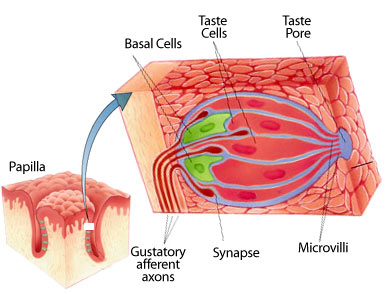
|
| Taste bud magnified: To the left is cross-sectional view of a papilla with the small white rectangle showing the location of the taste bud. On the right is a taste bud - a cluster of taste cells (receptor cells) gustatory afferent axons and their synapses with taste cells and basal cells. Microvilli at the apical end of the taste cells extend into the taste pore, the site where chemicals dissolved in saliva can interact directly with taste cells. |
If we greatly magnify our view inside the tongues papillae, we see the microscopic onion shaped taste buds [right]. In mammals, taste buds are aggregations of 30-100 individual elongated "neuroepithelial" cells (50-60 microns in height, 30-70 microns in width) which are often embedded in "papillae". Or to put it another way, actual taste buds are collections of cells contained on the top of or in the folds of the fungiform, circumvallate and foliate papillae. Some researchers regard these three groups of papillae as the only mechanisms by which taste sensations can be determined. However other researchers have located taste buds in the cheeks, a few in the mucosa of the soft palate, and in children on the sides and roof of the mouth, as well as approximately 2500 in the pharynx, larynx and epiglottis. Estimates of the total number of taste buds per person varies widely - between 5000 and 10000. (This helps to explain some of the differences in perception experienced by lovers of wine and food.)
Taste buds are composed of groups of about forty columnar epithelial cells bundled together along their long axis. Taste cells within a bud are arranged such that their tips form a small taste pore, and through this pore extend microvilli from the taste cells. The microvilli of the taste cells bear taste receptors and it appears that most taste buds contain cells that bear receptors for two or three of the basic tastes. In the tongue, the taste buds are innervated by the chorda tympani (a branch of the facial nerve) and the glossopharyngeal nerve. These nerves carry the taste messages to the brain.
Moving ever closer toward the buds, we notice interwoven among the taste cells in a taste bud is a network of dendrites of sensory "taste nerves". When taste cells are stimulated by binding of chemicals to their receptors, they depolarize and this depolarization is transmitted to the taste nerve fibres resulting in an action potential that is ultimately transmitted to the brain. One interesting aspect of this nerve transmission is that it rapidly adapts. After the initial stimulus, a strong discharge is seen in the taste nerve fibres but within a few seconds, that response diminishes to a steady-state level of much lower amplitude. Once taste signals are transmitted to the brain, several efferent neural pathways are activated that are important to digestive function. For example, tasting food is rapidly followed by increased salivation and by low level secretory activity in the stomach.
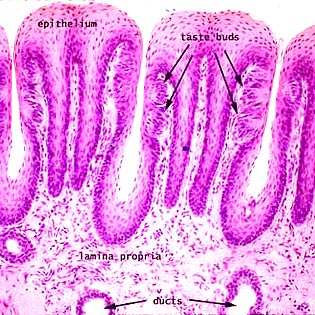
|
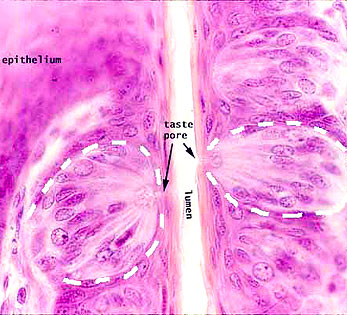
|
| Magnified image of papillae. |
Magnification of taste buds (approx. 400x) |
Contemporary science now knows a great deal about the periphery of the tongues functioning. However, the actual transduction pathways in taste as well as events further downstream in the brain remain mysterious. How do taste cells talk to the nervous system? How are signals from taste receptors integrated with those from olfactory receptors to form a representation of complex food flavours, for example? It is believed that the interactions which may be both chemical and electrical are actually responsible for pre-processing taste information before signals are transmitted to the brain. The actual mechanism that occurs in the transmission of the taste information process is being researched and it is thought that taste molecules activate taste cells by binding to receptor proteins in the cell membrane in a lock and key arrangement. However considerable research has to be undertaken to purify the receptor protein, and then violate the gene that it encodes, to fully understand the mechanism. Such research is highly specialised and a detailed account is beyond the scope of this study.
The Taste Sensation
Sniff, jiggle, roll the wine around the palate, make then the mandatory spit, and ponder. What did the 1996 Chateau Margaux really taste like? Traditionally, research has suggested four distinct categories of taste: salt, sweet, sour and bitter, each regionally localised on the tongue. Sweetness on the tip, saltiness on the front edges, sourness on the rear edge and bitterness at the back of the tongue.
We like the taste of common SALT (sodium chloride) because it is an essential dietary element and plays a major role in water homeostasis. As was pointed out in the last chapter, on average the body loses between 2 - 3 litres of water per day which it is necessary to replace in order to keep the balance of salts within the body. The ions of salt can pass directly through the ion channels in the tongue. Salt taste perception shows a pronounced variation across species and will depend upon the ion content of an animal's characteristic diet. Apparently, humans and animals with a carnivorous diet will obtain sufficient sodium salt within the cellular fluids of the meat that they devour. Modifications of salt taste ability occur in individuals as a long-term adaptation of dietary habit.
Because of our requirement for energy, we like tastes with a SWEET concentration - they are signifiers of potential nutritional value. Sweetness is produced by the presence of sugars, some proteins and several other substances. For many cultures, sweet food is prized above all others. The very word 'sweet' has become synonymous with hedonsitic pleasure, possibly induced or accompanied by a hypothalamic release of endorphins. In wine, sweetness is a sensation that is more than fruity, rather distinctly sweet due to the presence of sugar. Alcohol and glycerol also have a sweet taste, with alcohol enhancing the apparent 'sweetness' of wine. (These are not to be confused with diethylene glycol, as some Austrian winemakers did in 1985. It sweetened the wine, but killed the imbibers - being essentially anti-freeze and highly toxic.)
SOURNESS is the taste sense that detects ACIDS. Strong sourness causes avoidance reactions. Acids taken in excess are certainly not healthy and off food tends to go sour (acidic). In wine, the term "acid" is used to indicate the quality of tartness or sharpness to the taste; the presence of agreeable fruit acids. The main acids in wine are tartaric and malic. Balanced acidity is desirable and gives crispness in white wines. Sour and tart are common synonyms but are more descriptive of very high acid levels, with the opposite sensation described as "flatness" in wine.
A team led by Duke University Medical Center researchers in the U.S. has recently discovered two proteins in the taste buds on the surface of the tongue that are responsible for detecting sour tastes. The mechanism in the tongue for detecting sour taste is similar to that which detects salt taste.
While a BITTER taste may be appealing in small amounts(beer drinkers enjoy bitterness in their beverage), when concentrated, bitterness is unpleasant and undesirable. Bitterness, detected late on the palate is considered a fault in some wines in which the after-palate has a lingering bitterness (not to be confused with acidity in red table wines.) Avoiding bitterness is a major pre-occupation with white wine makers who go to great lengths to use very gentle pressing techniques in order to minimize skin contact, thus avoiding the harsh phenolics which can become apparent on the back palate experienced as an unpleasant bitter taste. Bitterness, even more so than sourness, triggers an avoidance response. Studies at New York University College of Dentistry(Spielman et al)concluded that "...... the tasting of bitter compounds may have evolved as a protective mechanism against ingestion of potentially harmful substances". This observation was made from studies carried out in mice. However, it has been observed that some animals are able to ingest certain bitter tasting plants in what is thought to be a process of self medication.
In my own experiments with Australian Native Bush Food, I have found that the lips and tip of the tongue pick up bitter tastes quite quickly and send signals to the brain urging caution. Bitter taste buds are concentrated in papillae located on the dorsal surface of the tongue, palate and pharynx.
Bitter compounds are found in foods and plant alkaloids such as:
1) - Caffeine
2) - Strychnine
3) - Quinine (the anti-malarial found in Tonic water.)
4) - Glycosides
5) - Cyanide
6) - Metabolic Waste Products
The bitterest substance known is the synthetic chemical 'denatonium' (marketed as Bitrex). Discovered in 1958, it is an odorless solid used as an aversive agent to prevent the accidental ingestion of toxic products.
Such are the four traditionally acknowledged taste sensations - Salt, Sweet, Sour & Bitter.
In the West, we probably developed this paradigm from Aristotle's concept of basic tastes which he cited as sweet and bitter, with succulent, salt, pungent, harsh, astringent and acid as elaborations of those two basics. In the East, the ancient Chinese "Five Elements" philosophy recognised only slightly different basic tastes: bitter, salty, sour, sweet and hot (although the Chinese have also long considered pungency as a taste).
The fact is that there is no evidence to suggest that individual taste buds, or even receptor cells, are specifically 'tuned' to a particular taste. Experiments with single fibre recording demonstrate responses to a combination of any of the four basic tastes from individual taste buds, and consequently it is believed that the quality of a perceived taste comes about as a result of the creation of an overall pattern of discharge from numerous buds. Such were the findings of MA Hess, Hess and Hunt Inc, Nutrition Communicators in Northfield, USA. They concluded that every taste bud has some degree of sensitivity to all the taste sensations, and that the brain is able to determine the precise nature of the taste by the ratio of stimulation of different taste buds. Despite this new knowledge, many textbooks still describe only four localised taste regions according to the traditional but misleading 'tongue map'.

